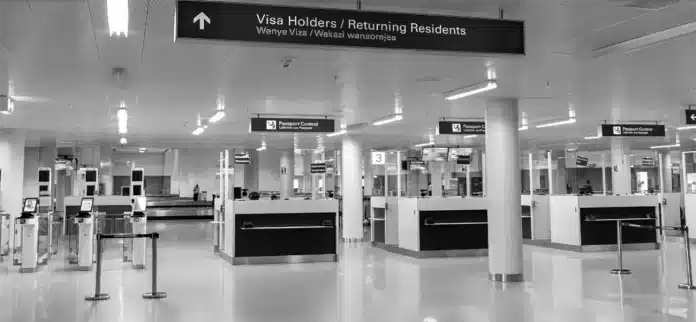Visa on Arrival or Evisa: Which is the Best Option for Traveling to Tanzania?
Planning a trip to Tanzania? Then you must be wondering about the best way to obtain a visa. Tanzania offers two popular options: Tanzania evisa or visa on arrival. But which one is the best choice for you? In this article, we will explore the advantages and disadvantages of both options to help you make an informed decision. Visa on Arrival allows you to obtain your visa upon arrival at the airport or border crossing, eliminating the need for pre-application. It offers convenience and flexibility, especially for those who have spontaneous travel plans. On the other hand, Evisa allows you to apply for your visa online before your trip, saving you time and hassle at the airport. It offers the advantage of knowing your visa is approved before you travel. So, whether you prefer the ease of Visa on Arrival or the peace of mind of Evisa, read on to discover the best option for your journey to Tanzania.
What Is a Visa on Arrival?
Visa on Arrival is a process that allows travelers to obtain their visa upon arrival in Tanzania. This means that you do not need to apply for a visa in advance; instead, you can simply show up at the airport or border crossing and apply for your visa on the spot. The process is relatively straightforward, and the visa is usually issued within a short period of time.
When any guest is in that decision making phase of choosing between the Tanzania evisa or visa on arrival process, one of the main reasons why they opt for the visa on arrival option in the end is because of the convenience it offers. If you have spontaneous travel plans or if you are unsure about your exact travel dates, Visa on Arrival allows you to be flexible. You don’t need to go through the hassle of applying for a visa beforehand and can simply obtain it upon arrival. This is particularly beneficial for travelers who may have last-minute changes to their itinerary or who prefer not to commit to specific travel dates in advance.
However, there are also some disadvantages to consider. First, there might be long queues and waiting times at the airport or border crossing, especially during peak travel seasons. This could potentially eat into your valuable travel time, so it’s important to factor in these potential delays when planning your trip. Additionally, the visa on arrival fees are generally higher compared to applying for an Evisa in advance.
In summary, when choosing between Tanzania evisa or visa on arrival, it’s good to note that the Visa on Arrival offers convenience and flexibility, making it a popular choice for many travelers to Tanzania. However, the potential waiting times and higher fees should be taken into account when deciding whether this is the best option for your trip.
What Is an Evisa?
An Evisa is an electronic visa that allows travelers to apply for their visa online before their trip to Tanzania. With an Evisa, you can complete the visa application process from the comfort of your own home, saving you time and hassle at the airport or border crossing. Once your Evisa is approved, it will be electronically linked to your passport, and you can simply present your passport at the immigration counter upon arrival in Tanzania.
When making a choice between the Tanzania evisa or visa on arrival, One of the main advantages of an Evisa to note is the peace of mind it offers. By applying for your visa in advance, you can ensure that your visa is approved before you travel. This eliminates the uncertainty and potential stress of applying for a visa on arrival and not knowing whether it will be approved. With an Evisa, you can travel with confidence, knowing that your visa is already taken care of.
Another advantage of an Evisa is the time-saving aspect. By applying online, you can avoid potential queues and waiting times at the airport or border crossing. This can be especially beneficial if you’re traveling during peak seasons or if you have a tight schedule and want to make the most of your time in Tanzania. Additionally, the fees for an Evisa are generally lower compared to obtaining a visa on arrival.
However, in choosing between the Tanzania evisa or visa on arrival, it’s important to note that there are some potential disadvantages with the eVisa to consider as well. The Evisa application process requires you to have access to the internet and a valid credit card for payment. If you don’t have reliable internet access or if you prefer not to share your credit card information online, then this option may not be suitable for you. Additionally, the Evisa application requires you to provide all the necessary documents and information accurately, and any mistakes or omissions could result in a delay or rejection of your application.
In summary, an Evisa offers the advantage of convenience, peace of mind, and time-saving. If you have access to the necessary resources and prefer to have your visa approved in advance, then this option may be the best choice for your trip to Tanzania.
How to Apply for a Visa on Arrival
When presented with the Tanzania evisa or visa on arrival options, If you decide that obtaining a visa on arrival is the best option for your trip to Tanzania, here is a step-by-step guide on how to apply:
- Check the requirements: Before your trip, make sure to check the specific visa requirements for your nationality. This includes the validity of your passport, any additional supporting documents needed, and the visa fees.
- Arrive at the airport or border crossing: Once you arrive in Tanzania, head to the visa on arrival counter at the airport or border crossing. Make sure to have all the necessary documents and payment ready.
- Complete the visa application form: At the counter, you will be provided with a visa application form to fill out. Make sure to provide accurate and complete information, as any mistakes or omissions could result in a delay or rejection of your visa.
- Pay the visa fee: After submitting your application form, you will be required to pay the visa fee. The fee can usually be paid in cash or sometimes by credit card, depending on the specific location.
- Receive your visa: Once your application and payment are processed, you will receive your visa. Make sure to double-check the details on the visa to ensure accuracy.
It’s important to note that the visa on arrival process may vary slightly depending on the specific airport or border crossing you arrive at. It’s always a good idea to do some research beforehand or consult with your travel agent to ensure a smooth and hassle-free experience.
How to Apply for an Evisa

When choosing between the Tanzania evisa or visa on arrival, it’s good to compare the pros and cons of the both visa options carefully. If having done this, you decide that the eVisa is the best option for you, here is a step-by-step guide on how to apply:
- Visit the official Evisa website: Tanzania has an official Evisa website where you can start your application process. Make sure to access the official website to avoid any scams or fraudulent websites.
- Create an account: To apply for an Evisa, you will need to create an account on the Evisa website. This will require providing your personal information and creating a username and password.
- Fill out the application form: Once you have created an account, you can start filling out the Evisa application form. Make sure to provide accurate and complete information, as any mistakes or omissions could result in a delay or rejection of your visa.
- Upload the required documents: The Evisa application process requires you to upload certain documents, such as a scanned copy of your passport, a recent passport-sized photograph, and any additional supporting documents as per the requirements.
- Pay the visa fee: After completing the application form and uploading the necessary documents, you will be required to pay the visa fee. The fee can usually be paid online using a valid credit card.
- Track your application: Once you have submitted your Evisa application, you can track its progress on the Evisa website. This will allow you to stay updated on the status of your application and know when your visa is approved.
- Receive your Evisa: Once your application is approved, you will receive your Evisa via email. Make sure to print a copy of the Evisa and keep it with you when traveling to Tanzania.
It’s important to note that the Evisa application process may take some time, so it’s recommended to apply well in advance of your planned travel dates. Additionally, make sure to carefully follow the instructions provided on the official Evisa website to ensure a successful application.
Which Option Is Best for Traveling to Tanzania?
Now that we have explored the advantages and disadvantages of both Visa on Arrival and Evisa, it’s time to determine which option is best for traveling to Tanzania. Is it the Tanzania evisa or visa on arrival? The answer ultimately depends on your personal preferences and travel plans.
If you value convenience and flexibility, and if you have spontaneous travel plans or prefer not to commit to specific travel dates in advance, then Visa on Arrival may be the best choice for you. It allows you to obtain your visa upon arrival at the airport or border crossing, eliminating the need for pre-application. However, it’s important to consider potential waiting times and higher fees when deciding on this option.
On the other hand, when deciding between the Tanzania evisa or visa on arrival, if you prefer peace of mind and want to have your visa approved in advance, then Evisa may be the best option for you. By applying online before your trip, you can ensure that your visa is approved before you travel, eliminating the uncertainty and potential stress of applying for a visa on arrival. Additionally, the time-saving aspect and lower fees make Evisa an attractive choice for many travelers.
Ultimately, the choice between Visa on Arrival and Evisa depends on your travel preferences, schedule, and comfort level. It’s important to carefully consider the advantages and disadvantages of each option and choose the one that aligns best with your needs.
Conclusion
Obtaining a visa is an essential part of planning any trip to Tanzania. Whether you choose Tanzania evisa or visa on arrival, both options have their own advantages and disadvantages. Visa on Arrival offers convenience and flexibility, while Evisa provides peace of mind and time-saving benefits. By understanding the application processes and considering your travel preferences, you can make an informed decision on the best option for your journey to Tanzania. So, book your flights, pack your bags, and get ready to explore the wonders of Tanzania knowing that your visa is taken care of. Safe travels!
For more articles related to Tanzania Immigration, click here!

































